|
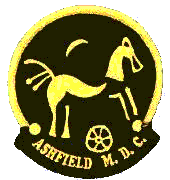
| |
EYES DOWN LOOK IN! |
|

|
DECISIONS! DECISIONS!
Judging a recent Find of
the Month Award are, round the table from left to right, David Hallam
Search Secretary, Anja Rhodes Finds Liaison Officer, Dennis Brown Club
Chairman and club member Mark Islip. |
Find Of The Month
July, 2008
Coin:- Gothic florin,
found by John Radford.
Artefact:- Georgian ring, found by Richard Waite. |
|
|
GOTHIC FLORIN
This beautiful coin, a Victoria Gothic florin, was found by John
Radford on a club search in July, it won the July, Find of the Month
Award.
The first silver florin minted in England was in 1849, it was soon
termed the ‘Godless’ florin because the words ‘Dei Gratia. Fid Def.’
were omitted from it. This omission caused a public outcry and the
person responsible for the error, the Deputy Master of the Royal Mint,
was dismissed. Some thought that the issue of the ‘Godless’ coin was the
cause of an outbreak of cholera in the same year. It was also the first
coin to state the value of the coin twice in words, ‘ONE FLORIN. ONE
TENTH OF A POUND’ on the obverse. An attempt to establish a decimal
coinage that was soon discarded.
The ‘Gothic’ florin found by John was so named because of its Old
English or Gothic lettering and the having the date in Roman numerals.
Issued from 1851 to 1887 it had on the obverse ‘VICTORIA. D.G. BRITT.
REG. F.D. which satisfied the religious concerns of the public. The
word 'Florin' on a two shilling coin was discontinued in
1937.
*** |
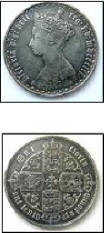
|
Find of the
Month August. 2008.
COIN. Edward 1
silver hammered penny. Darren Hoyle. No picture available.
ARTEFACT. Gold medieval padlock clasp. Darren Hoyle. This was
featured in the Summer, 2008 issue of the newsletter.
However to give an idea of how small the padlock
is, it is shown here at the side of a five pence coin. If you get
the chance please read the excellent article by John Radford, about
Darren’s find, in the December, 2008 issue of the Searcher Magazine. |
 |
Other finds made in August
|
 |
 |
 |
|
Pilgrim's ampulla
Dennis Brown |
Roman duck brooch
Darren Hoyle |
Early syringe
Dennis Brown |
|
Find Of The Month
September, 2008
COIN. Charles 1 Hammered
silver shilling 1645—1646. John Radford
ARTEFACT. Bronze Roman Ring. Dennis Brown. |
|
 Roman ring
Roman ring |
 |
Charles1 shilling |
Find Of The Month
October, 2008
COIN:- George111 gold half
guinea found by Dennis Brown
ARTEFACT:-
Roman Elagabalus denarius found by June Reedman. Jointly with a silver
thimble found by Dennis Brown. |
|
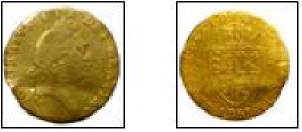 |
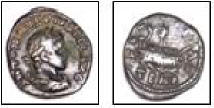 |
|
 |
|
Gold half guinea. |
Elagabalus denarius. |
|
Silver thimble. |
Other Finds Placed On The
Table
|
|
 |
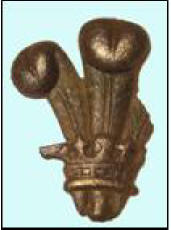 |
 |
|
Candle snuffer |
Prince of Wales feathers |
Half belt buckle 'HYOCATYS' on it. |
|
John Radford |
Dennis Brown |
Paul Wigginton
|
 |
 |
 |
|
Charles1 shilling
Gordon Reedman |
Roman Brooch
Bill Severn |
William111 shilling
John Radford |
A
TERRIFIC ACCESSORY— BUT IS IT ANOTHER RIP OFF?
John Gough.
On a club search in November, I
noticed that two of the club members, June and Graham Reedman
had the new Garrett Pro-Pinpointers. They gave myself and other
club members a demonstration of the new accessory. I was well
impressed and after reading the Product Report in the Treasure
Hunting magazine, December issue, I decided to buy one. Four
stockists advertised them in both hobby magazines at £74.99 post
free.
I had dealt many times in the past with Regton and had not
encountered any problems so I telephoned my order. Imagine my
surprise when I was told that the price was not as advertised
£74.99 post free but £84.99 post free, an increase of £10, and
this was do to the unfavourable dollar/pound exchange rate. A
£10 increase on a £75 item is 13.33%, which seems to be
extortionate, if the pound has fallen by that much we are in
deep doo-doo indeed. This appears to be another rip off that we
as detectorists are prone to!
Regton are the agents for Garrett and supply the other outlets.
One of the other stockists told me that they have had to follow
suit with the price increase. |
|
 |
|
As to the Garrett Pro-Pinpointer
I have found that it does all it says in the full page Regton
advertising blurbs in the magazines. However if any club member
is a prospective purchaser and undecided they are welcome to
have a
short
trial with mine.
The Product Report in the Treasure Hunting Magazine is a good factual
article and should be read by anyone thinking of buying a Pro-Pinpointer.
A SERIOUS BIT OF KIT. A SERIOUS PRICE. A
SERIOUS RIP OFF.
*** |
FIND OF THE MONTH UPDATE
|
|
January, 2008 to October, 2008. |
| |
January. |
Henry 111 silver
hammered penny. John Radford.
Roman Brooch. John Wardle. |
| |
February.
|
George 111 gold
spade guinea. Bill Severn.
Two lead tokens. John Wardle. |
| |
March. |
Elizabeth 1
silver hammered three-pence. John Wardle.
Gold noble coin weight. Roger Bacon. |
|
Find of the Year 2007—2008.
George 111 gold spade guinea. Bill Severn.
Celtic horse cheek piece. Joint John Wardle and John Radford. Jointly. |
| |
April. |
Edward 11 silver
hammered penny. Roger Bacon.
Buckle. John Radford. |
| |
May . |
John Balliol,
hammered silver penny. Graham Reedman.
Silver thimble. John Wardle. |
| |
June. |
Edward 1
hammered silver penny. Mary Severn.
Gold ring. Dennis Brown. |
| |
July |
Victoria Gothic
florin. John Radford.
Georgian ring. Richard Waite. |
| |
August. |
Edward 1 silver
hammered penny. Darren Hoyle.
Gold medieval padlock/clasp. Darren Hoyle. |
| |
September.
|
Charles 1
hammered silver shilling. John Radford.
Roman Ring. Dennis Brown. |
| |
October. |
George 111 gold
half guinea. Dennis Brown.
Elagabalus denarius. June Reedman. Jointly.
Silver Thimble. Paul Wigginton. |
|
CLUB RALLY BEST NATURAL FIND. Pocket watch. John Radford. |
 |
LEAD SHOT
MOULD
Dennis Brown, the
club chairman, made an interesting find on one of his
own sites. It was half a mould for making the lead shot
that metal detectorists usually call, rightly or
wrongly, musket balls.
Never one to take things at face value Dennis decided
to see if he could make a complete mould based on the
half he had found. He made a plaster mould of his half
and melted a quantity of scrap lead (all detectorists
have some) and cast the matching half. They fitted
together perfectly. Not satisfied he decided to cast a
lead shot from the completed mould so he melted a stick
of solder and filled the mould with it.
When the metal had set he was delighted to find
he had a cast a lead shot complete with a tail of sprue.
Full marks to Dennis for ingenuity.
|
 |
|
Top left. Original find.
Bottom left. Filled mould. |
|
Top right. Duplicated
mould.
Bottom right.Opened mould. |
|
 |
 |
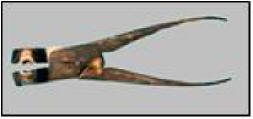 |
|
Shot with sprue showing. |
Shot trimmed by computer |
Bullet pincers. Lead was poured into
the closed jaws. |
|

Mary Severn |
A FIND OF THREE
HALVES
On a recent club search Mary Severn found half a
Roman denarius. She thought it may be the missing half of a
coin found earlier on the same field by another club member.
On comparing them it was obvious that they were from two
different coins. Mary was determined to find the missing
half of her coin and painstakingly searched the area. Then,
at last, she found it. Now we can go home Bill her husband
was heard to say!
 |
CHRISTMAS HUMOUR
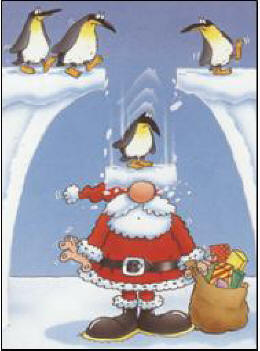
|
|
Cleaning coins and artifacts with ammonia.
As most members of the club know I am saving and
recording the small brass “trouser” buttons with the
name of a tailor or outfitter on them. Most of the
buttons are in a bad state when recovered from the soil
and need a lot of cleaning before they are suitable for
photographing. I used a mixture of household chemicals
(mainly Cillit Bang) and a fibre glass brush to remove
the encrustation on them, this was not successful in a
lot of cases and the names on the buttons remained
unreadable
I happened to read on the UK Detector Finds Database
website, www.ukdfd.co.uk, that John Stokes had a method
of cleaning with household ammonia. I contacted him and
he kindly gave me permission to include details in the
club newsletter.
I have since cleaned buttons and other items with
ammonia and have had considerable success. Details of
the ammonia treatment is given below with the caution to
try it out at first on some unimportant item. John
Stokes and the Ashfield Metal Detecting Club accept no
liability if the user gets it wrong.
AMMONIA
CLEANING SYSTEM.
JOHN
STOKES
Cleaning should be fairly easy using the ammonia
treatment. The fibre glass brush comes into use at the
end of cleaning.
You will need;- A smallish plastic tumbler, (about 4
inches high).
A stiff toothbrush, (Superdrug
still do them).
A fiberglass brush.
Boots household ammonia,
barcode 05143764.
Method :- Put the item to be cleaned into the tumbler,
standing it on edge against the side. Put warm water in,
to just cover the item, and then add about a 50%
quantity of ammonia, i.e. 2/3 water to 1/3 ammonia.
You can then go and have a cuppa, or whatever else
you need to do. The mixture will start to go blue, which
shows that it is working. Leave it for about ten
minutes, or until it has gone to a RAF blue, (mid
colour). Take out the piece, and wash it under cold
running water, whilst brushing it with the toothbrush.
Most of the crud should be off at this stage, but if
there is a little left on don't worry.
Allow the item to dry completely, DO NOT use
the fibre-glass brush on any wet items, (it will ruin
the brush). Once you are satisfied that it is totally
dry, you can then brush off any residue crud, but only
ever brush in one direction, (not back and forwards),
preferably away from your body, because of the glass
particles floating around. I also use thin rubber
gloves, again because of the bits of glass. Don't brush
too hard, otherwise you will put nasty scratches onto
your item.
The above will, in all but the worst cases, be
sufficient to do the job. However, if when you have done
it, you are still not happy, then you can place it back
in the mixture for a while. Experience will tell you
when things are cleaned sufficiently as you use it more.
Do not use the same mixture of ammonia and water on
different metals, just one metal at a time.
Once again many thank to
John Stokes and UK Detector Finds Database.
*** |
|
ELAGABALUS SILVER DENARIUS
This silver denarius of
Elagabalus was minted in 218AD. at Antioch. The obverse
pictures the laureate head of Elagabalus with the legend
ANTONINVS PIVS FEL AVG. The reverse pictures a galley
with sail and rowers proceeding right, at the prow is
the pilot, acrosolium ( decoration on the prow of a
ship), and at the stern a furled sail. With FELICITAS
around and TEMP in the exsurge. Seaby Roman Silver Coins
Volume 3, Elagabalus number 27. B.M.C. 277, R.I.C. 188.
 The coin was found by June Reedman on a club search and
was awarded joint October, 2008, Find of the Month
The coin was found by June Reedman on a club search and
was awarded joint October, 2008, Find of the Month
 Award. Initially it was identified as a denarius of
Antoninus Pius 138—161A.D. But luckily the error was
discovered before the certificate was presented.
Varius Avitus Bassianus surnamed Elagabalus after being
appointed Priest of Elagabalus whose worship he
introduced to Rome. He was born in 205A.D., and at
thirteen years of age he became the sole master of the
Roman world. His was a reign of cruelty, extravagance
and folly, after three years and nine months his
soldiers killed him and his mother Soæmias throwing
their bodies into the Tiber.
Award. Initially it was identified as a denarius of
Antoninus Pius 138—161A.D. But luckily the error was
discovered before the certificate was presented.
Varius Avitus Bassianus surnamed Elagabalus after being
appointed Priest of Elagabalus whose worship he
introduced to Rome. He was born in 205A.D., and at
thirteen years of age he became the sole master of the
Roman world. His was a reign of cruelty, extravagance
and folly, after three years and nine months his
soldiers killed him and his mother Soæmias throwing
their bodies into the Tiber.
*** |
|
FIGURES ON ROMAN COIN REVERSES
Here is the second set of ten drawings of figures
that may be found on the reverses of Roman coins found
in Britain. |
|

11. FECVNDITAS
12. FELICITAS
13. FIDES
14. FIDES MILITVM
15. FORTVNA |
|

16. GENIVS
17. HILARITAS
18. IVNO
19. IVPITER
20. LAETITIA |
|
11, FECVNDITAS. Fertility, usually of the Empress.
Female figure with or holding children.
12. FELICITAS. Felicity,
public happiness and prosperity. Female figure holding
caduceus, corn or sceptre.
13. FIDES. Good faith,
fidelity, loyalty and confidence. Female figure holding
corn ears and basket of fruit.
14. FIDES MILITVM. The
loyalty and fidelity of the soldiers. Female figure
holding two standards.
15. FORTVNA. Fortune.
Female figure holding rudder, cornucopia and sometimes
an olive branch.
16. GENIVS. Genius the
spirit. Male figure holding a patera and cornucopia with
an altar at his feet.
17. HILARITAS. Hilarity.
Mirth and rejoicing. Female figure holding palm and corn
with one or two children at her feet.
18. IVNO. Juno the
consort of Jupiter. Female figure holding patera and
hasta with a peacock at her feet.
19. IVPITER. Jupiter or
Jove, king of the Gods and mankind. Male holding a
thunderbolt, at his feet an eagle and an altar.
20 LAETITIA. Joy,
gladness and well founded. Female figure corn ears in
her right hand and a hasta pura ( a spear shaft without
the iron head) in her left hand.
JMBG |
|
UNUSUAL HALLMARK.
On a recent club search I recovered the rear
of a pocket watch casing. It appeared to be silver
and I examined that hallmarks to see if I could date
it. I usually have in the car a small pocket size
book ‘English Silver Hallmarks’ edited by Judith
Bannister, however this time I had left it at home.
When I arrived home I looked in the book and found
that none of the usual assay office marks matched
the one on the watch casing. Then I found that the
mark was of the London Assay Office but for
platinum, not silver. It appears that in 1973 all
articles containing platinum at 950 parts per 1000
or over had to be hallmarked. The first year for
marking platinum was 1975, starting with ‘A’. The
letter ‘i’ and the import mark meant that the watch
case was imported and then hallmarked in 1983 by the
London Assay Office.
JMBG |
 |
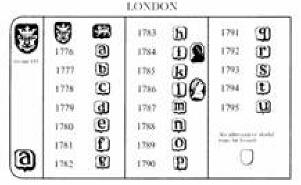
The English Silver Hallmarks book, edited by Judith
Bannister, in the Dealers Guides series. This is the
second one of these books I have had since the early
1980s. The panel illustrated above is an extract
from one of the pages, it shows how easy the book is
to use.
|
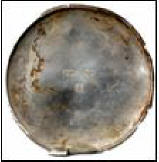
Platinum watch casing. |
|
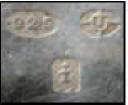
Hallmarks in full.
 |
|
Platinum import mark. |
BOOKS
|
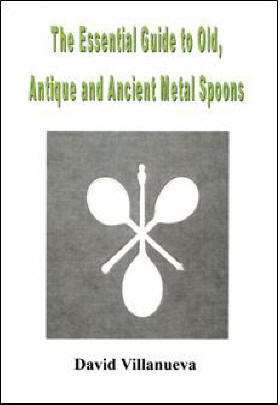 |
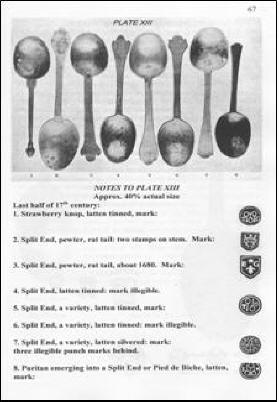 |
|
In this newsletter I would like to introduce you
to a book I have only recently purchased. It is
The Essential Guide to Old, Antique and Ancient
Metal Spoons by David Villanueva it is soft
covered, A5 in size with 88 pages and is
extremely well illustrated.
David Villanueva is a metal
detectorist of over 30 years experience, he has
written various other books to do with the
hobby. Information about these books can be
found on the web site
www.truetreasurebooks.com.
This book is described as “ A
profusely illustrated guide to spoons for
finders, collectors, family historians and
anyone interested in spoons from the earliest
times to the nineteenth century. The book is
basically divided into three sections: the first
covers the development of spoons particularly
silver, from earliest times; the second covers
old base metal spoons and the third some
continental spoons, many of which have been
found in Britain. Whatever old spoon you may
come across or want information on, you should
find it in this book.”
The
good news is that it won’t break the bank, only
£5 including postage and package, if not
ordering online the book can be obtained from
True Treasure Books, David Villanueva, 43,
Sandpiper Road, Whitstable, Kent. CT5 4DP.
*** |
RICHARD1 1109
- 1216
|
|
 |
|
|
|
BUTTONS
For a number of years John Gough,
has collected the small brass
advertising or trader's buttons, like
the two illustrated here. Most of us
regard these little buttons as an
annoyance and more than likely they are
consigned to the hedge bottom or junk
box in disgust. Realising that the
buttons are being degraded by the
minerals and fertilizers in the soil he
started to save them, he is recording
them individually and researching the
persons or companies named on them with
the intention of writing a book about
them and their buttons. Would club
members please save these buttons in any
condition for him with, if known, a note
of the general area where found e.g.
Newark or Cotgrave.
***
DRESS
HOOK FASTENERS.
Both these dress hook fasteners were
found by John Gough on a recent club
search within a yard of each other.
They are thought to be
Tudor in date however that will be
determined when the report is completed
by the Finds Liaison Officer, Anja
Rohde.
It is amazing how they remained virtually together in the soil for
four hundred years in spite of the many
ploughings and other movements of the
soil during that time.
|

|
|
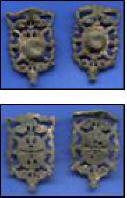 |
THAR’S GOLD IN THEM THAR FIELDS.
Bleep! Bleep! What’s this, a pull
ring?
Oh! No! By Jove a gold ring.
And there’s a silver penny.
Of these you don’t find many.
Now I’m doing really well.
Isn’t this a crotal bell?
Buttons, tokens, by the score.
Keep on digging I’ll find more.
Now I’m really over the moon
When up pops a silver spoon;
Be careful that the silver thimble
Doesn’t slip through fingers nimble.
My! O my! The words are stammered
When I find a silver hammered.
Celtic, Roman, Saxon ware,
Nobles sprinkled here and there.
At last my dreams have all come true
But suddenly out of the blue,
Bells are ringing in my ears,
Realising all my fears.
It’s all a dream—I’m feeling blue,
But who knows? Sometimes dreams come
true.
D
& C Crabtree. |
|
